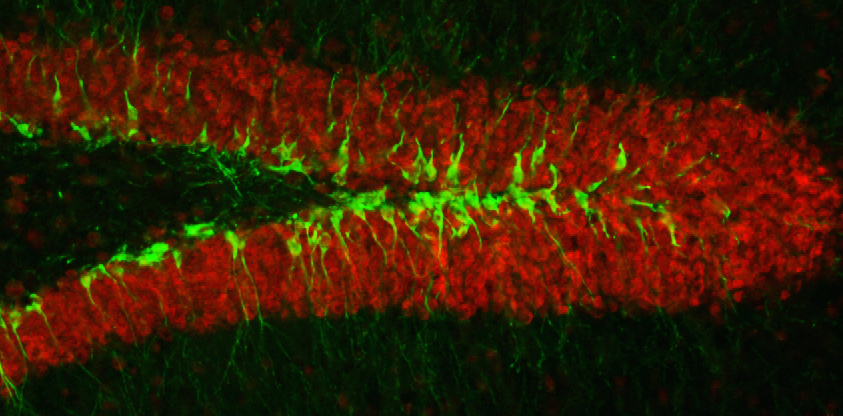
Keywords: Adult neurogenesis, neural stem cells, medulloblastoma
My research is focused on the study of the processes of adult neurogenesis, muscle regeneration and tumorigenesis of medulloblastoma (MB, cerebellar tumor), with particular regard to the cellular and molecular mechanisms implicated.
During my Ph.D. studies and post-doc, I contributed to characterize the role of the gene PC4/IFRD1 in muscle regeneration and of the antiproliferative genes Btg1 and Btg2 in the adult neurogenesis of the neurogenic niches (dentate gyrus and subventricular zone) and in the cerebellum.
Principal research lines in which I am currently involved, in close collaboration with Dr. Felice Tirone, can be summarized as follow:
– investigating the functional role of cell cycle regulatory genes (Btg1, Btg2, and p16) in the balance between quiescent and proliferative state of stem cell pool in the neurogenic niches of the adult brain, in physiological and pathological conditions, employing mouse models with impaired neurogenesis and specific neurogenic stimuli (running, antidepressants, diet components);
– studying the processes that regulate the development of cerebellum and tumorigenesis of the medulloblastoma, for the identification of future therapeutic targets.
To approach these issues, we carry out both in vivo and in vitro studies using specific genetically modified mouse models and molecular/cellular methods.

Education:
- December 1998 Degree summa cum laude in Biological Sciences, University “La Sapienza”, Rome, Italy. Title of dissertation: “Isolation and study of the promoter region of IFRD1(PC4), gene induced by NGF”.
- November 1998-October 2001 PhD in Biological and Biochemical Evolution, University of Viterbo, Italy. Title of dissertation: “Studies of the biological and molecular function of the NGF-inducible gene IFRD1(PC4), regulator of muscle differentiation”.
Positions:
- November 2001-October 2005
Post-doc fellowship at the Institute of Neurobiology and Molecular Medicine, National Council of Research, Rome. - November 2005-October 2006
Post-doc fellowship (Fondazione Telethon) at the Institute of Neurobiology and Molecular Medicine, National Council of Research, Rome. - November 2006-October 2007
Post-doc fellowship CNR at the Institute of Neurobiology and Molecular Medicine, National Council of Research, Rome. - December 2007- January 2017
Non-tenured researcher at the Institute of Neurobiology and Molecular Medicine, National Council of Research, Rome. - February 2017-Today
Tenured researcher at Institute of Biochemistry and Cell Biology, Monterotondo, Rome.
Patents:
Patent for a new therapy of medulloblastoma:
Patent CNR: “Cxcl3 chemokine for the therapeutic treatment of medulloblastoma” WO 2014053999 A1; Publication date 10 apr 2014; registration date 2 ott 2013. Tirone F., Cavallaro S., Farioli-Vecchioli S., Micheli L., Leonardi L., Cinà I., Ceccarelli M.
D’Andrea G, Ceccarelli M, Bernini R, Clemente M, Santi L, Caruso C, Micheli L*, Tirone F. Hydroxytyrosol stimulates neurogenesis in aged dentate gyrus by enhancing stem and progenitor cell proliferation and neuron survival. FASEB J. 2020 Feb 6. doi: 10.1096/fj.201902643R. *Co-corresponding author.
Micheli L, D’Andrea G, Ceccarelli M, Ferri A, Scardigli R, Tirone F. p16Ink4a Prevents the Activation of Aged Quiescent Dentate Gyrus Stem Cells by Physical Exercise. Front Cell Neurosci. 2019 Feb 7;1 3:10. doi: 10.3389/fncel.2019.00010. eCollection 2019.
Micheli L, Ceccarelli M, D’Andrea G, Costanzi M, Giacovazzo G, Coccurello R, Caruso C, Tirone F. Fluoxetine or Sox2 reactivate proliferation-defective stem and progenitor cells of the adult and aged dentate gyrus. Neuropharmacology. 2018 Oct; 141:316-330. doi: 10.1016/j.neuropharm.2018.08.023. Epub 2018 Aug 22.
Farioli-Vecchioli S, Cinà I, Ceccarelli M, Micheli L, Leonardi L, Ciotti MT, De Bardi M, Di Rocco C, Pallini R, Cavallaro S, Tirone F. Tis21 knock-out enhances the frequency of medulloblastoma in Patched1 heterozygous mice by inhibiting the Cxcl3-dependent migration of cerebellar neurons. J Neurosci. 2012 Oct 31;32(44):15547-64. doi: 10.1523/JNEUROSCI.0412-12.2012.
Micheli L, Leonardi L, Conti F, Maresca G, Colazingari S, Mattei E, Lira SA, Farioli-Vecchioli S, Caruso M, Tirone F. PC4/Tis7/IFRD1 stimulates skeletal muscle regeneration and is involved in myoblast differentiation as a regulator of MyoD and NF-kappaB. J Biol Chem. 2011 Feb 18;286(7):5691-707. doi: 10.1074/jbc.M110.162842. Epub 2010 Dec 2.
1) 21/01/2010. Che memoria ha quel neurone! Identificata per la prima volta la funzione essenziale di PC3/Tis21/BTG2 nello sviluppo neuronale e nel processo di formazione delle memorie. https://www.cnr.it/it/comunicato-stampa/4942/che-memoria-ha-quel-neurone
2) 20/11/2012. Una chemiochina contro il medulloblastoma. Studiando la trasformazione neoplastica delle cellule ‘progenitrici’ dei neuroni del cervelletto – l’evento dal quale trae origine il medulloblastoma – un gruppo di ricercatori dell’Istituto di biologia cellulare e neurobiologia del Consiglio nazionale delle ricerche (Ibcn-Cnr), in collaborazione con l’Istituto di scienze neurologiche del Cnr e Fondazione Santa Lucia, ha scoperto in modello murino che la molecola responsabile della frequenza con cui tale neoplasia insorge è una chemiochina che regola la migrazione dei progenitori neuronali. https://www.cnr.it/it/comunicato-stampa/5406/una-chemiochina-contro-il-medulloblastoma
3) 17/02/2020 L’olio fa bene al cervello, soprattutto negli anziani. Identificato il ruolo anti-invecchiamento neurale in vivo di un componente dell’olio extravergine di oliva, l’idrossitirosolo, presente in abbondanza anche negli scarti di lavorazione. Riscontrati particolari effetti benefici negli anziani. I risultati pubblicati su Faseb Journal sono stati dimostrati da una équipe di ricercatori del Cnr e della Università della Tuscia
